We all know whole grains are better than refined grains or processed grain products. Quinoa, brown rice and oats seem to be the main-stays of whole grains in most kitchens. However, I think it’s safe to say that many folks aren’t sure how to cook such things as amaranth, farro, barley, wheat berries, wild rice, millet, kamut, etc. However, I cook with them instead of things like rice or pasta. Why are whole grains better?
Well, whole grains have not been processed to the point where the bran (outer layer) has been stripped away. This part contains good stuff – healthy oils, fiber, protein, iron, potassium and manganese. The fiber in whole grains takes your body longer to digest. In combination with the protein in the grain, this fiber also helps you to feel fuller longer and doesn’t create a spike or quick rise in blood sugar. And, you know me . . . I’m all about stabilizing blood sugar levels for not only health, but for athletic performance.
When you are purchasing items marked as containing “whole grains”, you always want to look at the ingredients label. The grains in the product must be listed as “whole” in order to be legit. To really ensure that you are getting whole grains, you can always do what I do – cook your own. You can find many of these whole grains in your grocery store, especially in the dry goods or bulk bins section. They don’t cost a lot. You also won’t get bored with the many varieties.
Now, some of these grains take a while to cook. So, perhaps make them on a night that you have more time to cook dinner. You could also cook many of the grains on a Sunday to have pre-cooked and ready-to-go for the rest of the week. Some of the grains, like kamut, benefit from soaking to speed up the cooking time. I recommend the soak overnight – it’s easy and you cut your cooking time in half.
The grain recipe I’ve got for you today is made with kamut. It is an ancient, heirloom variety of wheat from the Middle East. In comparison to modern wheat, kamut has higher levels of lutein, beta-carotene and protein. In fact, it’s got approximately 7 grams of protein, 4 grams of fiber and only 160 calories per half cup, cooked. It’s high in selenium, zinc and manganese. Here’s the fabulous pilaf I made last night with our fish and veggies.
- 1 cup kamut wheat (I bought Bob’s Red Mill) – soaked a minimum of 8 hours up to overnight
- 2 cups of veggie or chicken broth
- 1 small red onion, diced
- 1 bay leaf
- 1/8 teaspoon salt
- ½ cup of nuts of your choice, chopped (I used pecans)
- ½ cup of dried fruit of your choice, chopped (I used a combination of dried blueberries and dried cherries)
Combine the soaked and drained kamut with the broth, onion, bay leaf and salt in a pot. Bring to a boil. Give it a stir, then cover it and leave on a low simmer for about 60 – 70 minutes. Check for doneness. It should feel a bit al dente. Continue to cook a little more, if needed. Otherwise, put the nuts and fruit on the top and cover the pot again. Let it sit off of the heat for another 5 – 10 minutes. Stir and fluff the grains. Makes about 4 – 6 servings. It’s so good!
Bonus – I topped a scoop of the kamut pilaf with couple of eggs scrambled with some arugula. Oh my! Yummy lunch.

